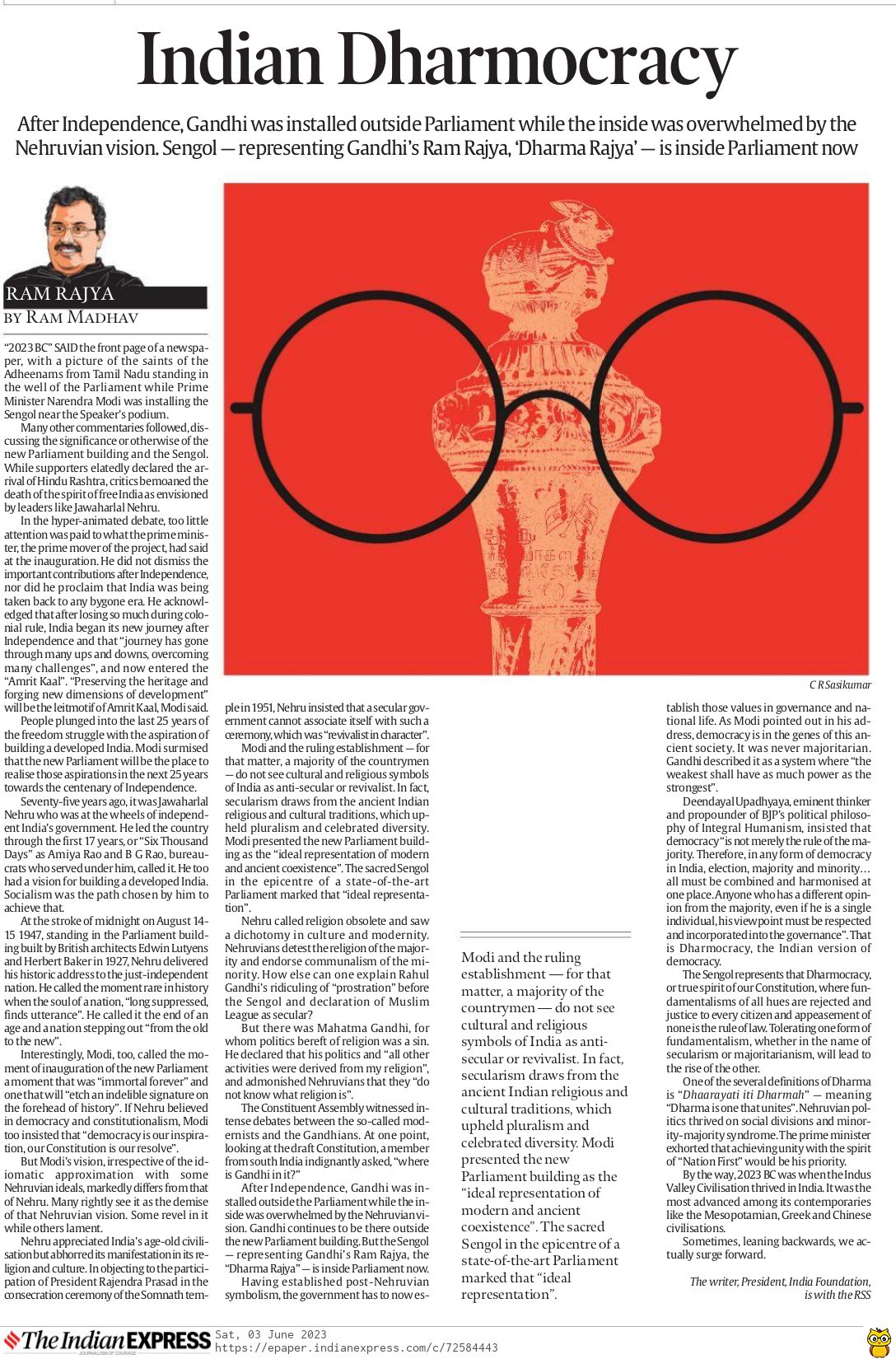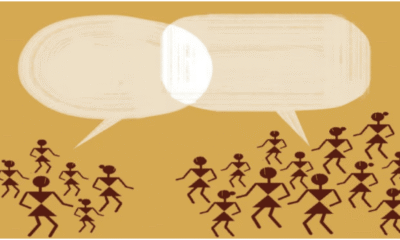
|
Getting your Trinity Audio player ready...
|
(The article was originally published by Indian Express on June 2, 2023 as a part of Dr Madhav’s bi-weekly column titled ‘Ram Rajya’. Views expressed are personal.)
“2023 BC” – blared the headline of an English daily published from Kolkata. It had a picture of the saints of the Adheenams from Tamilnadu standing in the well of the parliament while Prime Minister Narendra Modi was installing the Sengol near the Speaker’s podium. “Is this the noble mansion that we had dreamed of?”, it cynically lamented.
Many other commentaries followed discussing the significance or otherwise of the new parliament building and the Sengol. While the supporters elatedly declared the arrival of Hindu Rashtra, the critics bemoaned the death of the spirit of free India as envisioned by leaders like Jawaharlal Nehru.
In the hyper-animated debate, too little attention was paid to what the Prime Minister, the prime mover of the project, had said at the inauguration. He did not dismiss the important contributions after independence, nor did he proclaim taking India back to any bygone era. He acknowledged that after losing so much during the colonial rule, India began its new journey after independence and that “journey has gone through many ups and downs, overcoming many challenges”, and now entered the ‘Amrit Kaal’ of independence. “Preserving the heritage and forging new dimensions of development” will be the leit motif of the Amrit Kaal, Modi averred.
People plunged into the last twenty-five years of the freedom struggle with the aspiration of building a developed India. Modi surmised that the new parliament will be the place to realise those aspirations in the next twenty-five years towards the centenary of independence.
Seventy-five years ago, it was Jawaharlal Nehru who was at the wheels of independent India’s government. He led the country through the first seventeen years, or “Six Thousand Days” as Amiya Rao and B G Rao, the bureaucrats served under him called it. He too had a vision for building a developed India. Socialism was the path chosen by him to achieve that.
At the stroke of midnight on 14-15 August 1947, standing in the parliament building built by British architects Edwin Lutyens and Herbert Baker in 1927, Nehru delivered his historic address to the just-independent nation. He called the moment rare in history when the soul of a nation, “long suppressed, finds utterance”. He called it end of an age and a nation’s stepping out “from the old to the new”.
Interestingly, Modi too called the moment of the inauguration of the new parliament “immortal forever” and will “etch an indelible signature on the forehead of history”. If Nehru believed in democracy and constitutionalism, Modi too insisted that the “democracy is our inspiration, our Constitution is our resolve”.
But Modi’s vision, irrespective of the idiomatic approximation with some Nehruvian ideals, markedly differs from that of Nehru. Many rightly see it as the demise of that Nehruvian vision. Some revel in it while some repent.
Nehru appreciated India’s age-old civilisation but abhorred its manifestation in its religion and culture. In objecting to the participation of President Rajendra Prasad in the consecration ceremony of the Somnath temple in March 1951, Nehru insisted that a secular government cannot associate itself with such a ceremony, which was “revivalist in character”.
Modi, and the ruling establishment – for that matter a majority of the countrymen – do not see cultural and religious symbols of India as anti-secular or revivalist. In fact, secularism draws from the ancient Indian religious and cultural traditions, which upheld pluralism and celebrated diversity. Modi presented the new parliament building as the “ideal representation of both the modern and ancient coexistence”. Sacred Sengol in the epicentre of state-of-the-art parliament marked that “ideal representation”.
Nehru called religion obsolete and saw a dichotomy in culture and modernity. Nehruvians detest religion of the majority and endorse communalism of the minority. How else can one explain Rahul Gandhi’s ridiculing of “prostration” before the Sengol and declaration of Muslim League as secular?
But there was Mahatma Gandhi, for whom politics bereft of religion was a sin. He declared that his politics and “all other activities were derived from my religion”, and admonished Nehruvians that they “do not know what religion is”.
The Constituent Assembly witnessed intense debates between the so-called modernists and the Gandhians. At one point, looking at the draft constitution, a member from South India indignantly asked, “where is Gandhi in it?”
After independence, Gandhi was installed outside the parliament while the inside was overwhelmed by the Nehruvian vision. Gandhi continues to be there outside the new parliament building. But the Sengol – representing Gandhi’s Ram Rajya, the “Dharma Rajya” – is inside the parliament now.
Having established post-Nehruvian symbolism, the government has to now establish those values in governance and national life. As Modi pointed out in his address, democracy is in the genes of this ancient society. It never was majoritarian. Gandhi described it as a system where “the weakest shall have as much power as the strongest”.
Deen Dayal Upadhyay, eminent thinker and propounder of BJP’s political philosophy of Integral Humanism, insisted that democracy “is not merely the rule of the majority. Therefore, in any form of democracy in India, election, majority and minority… all must be combined and harmonised at one place. Anyone, who has a different opinion from the majority, even if he is a single individual, his viewpoint must be respected and incorporated into the governance”. That is Dharmocracy, the Indian version of democracy.
Sengol represent that Dharmocracy, or true spirit of our Constitution, where fundamentalisms of all hues are rejected and justice to every citizen and appeasement of none is the rule of law. Tolerating one form of fundamentalism, whether in the name of secularism or majoritarianism, will lead to the rise of the other.
One of the several definitions of Dharma is “Dhaarayati iti Dharmah” – meaning “Dharma is one that unites”. Nehruvian politics thrived on social divisions and minority-majority syndrome. Prime Minister exhorted that achieving unity with the spirit of “Nation First” would be his priority.
By the way, 2023 BC was when the Indus Valley Civilisation thrived in India. It was the most advanced among the contemporaries like Mesopotamian, Greek and Chinese.
Sometimes, leaning backwards, we actually surge forward.





Very informative and apt ji